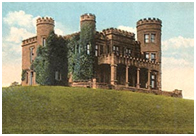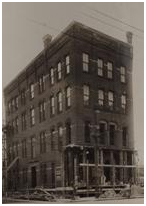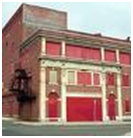The city of Holyoke has a complex and fascinating history of immigration and migration. Once considered the Paper Capital of the World, and home to premier cotton and silk mills, the history of Holyoke offers a microcosm of American industrial development. Founded in 1873 as one of the nation’s first planned industrial cities, Holyoke attracted successive waves of Irish, French Canadian, German, Polish, Jewish, and Italian immigrants who worked in the mills, established small businesses, raised their families, and created communities defined largely by ethnic and religious affiliation. However, by the mid-twentieth century, Holyoke, like so many American cities, found its industrial base rapidly disappearing. In the 1960s the most recent wave of people began re-creating Holyoke. Puerto Rican migrant farm workers, attracted by jobs in Western Massachusetts, began settling in old tenement houses once inhabited by earlier immigrant groups. But economic opportunities made possible by plentiful factory labor were no longer available. Holyoke, like scores of American cities, faced an uncertain future in the post-industrial era.
From the late 1970s through the mid-1980s Holyoke was briefly known as the arson capital of the United States, called by its residents “Holy Smokes.” Rumors abound that the most recent population of migrants set fires, when in fact it was absentee landlords burning their property for insurance money. Fires led to demolition. Dilapidated buildings were not only a drain on property owners’ money, city departments’ budgets and an eye-sore, but also provided safety hazards to neighboring buildings and locals.
Holyoke’s citizens have long (and short) memories, but have we learned from our past? Local coffee shops are filled with Holyokers chiming in: “Remember when the City tore down Kenilworth Castle? No one in their right mind could see that coming!” “It was a shame!” “Did you see that they tore down that Skinner building on Main Street?” “What’s next? City Hall?”
The following are examples of a typical city’s issues and challenges to realign the needs of city government with their community and citizens they are charged to support and educate.
 Kenilworth Castle was built in 1894 and sat on a hill with a commanding view of the Connecticut River. The Taft Family built it as a summer home to resemble an English castle. Throughout the years, the home passed to various family members and in 1957, a woman left the home to the Hadley Falls Trust Company, who had difficulty finding a buyer for the eclectic property. The Holyoke Water Power Company bought the building in 1959 and considered putting a power station on the land. The proposal was thought to be too expensive, so they changed plans to moving their offices there. However, a study found that the building lacked significant historical value and it was considered unsound. The building was demolished in 1959.
Kenilworth Castle was built in 1894 and sat on a hill with a commanding view of the Connecticut River. The Taft Family built it as a summer home to resemble an English castle. Throughout the years, the home passed to various family members and in 1957, a woman left the home to the Hadley Falls Trust Company, who had difficulty finding a buyer for the eclectic property. The Holyoke Water Power Company bought the building in 1959 and considered putting a power station on the land. The proposal was thought to be too expensive, so they changed plans to moving their offices there. However, a study found that the building lacked significant historical value and it was considered unsound. The building was demolished in 1959.
The Skinner Coffee House, built in 1914, received new life when it was purchased by Belle and Katharine Skinner, two members of Holyoke’s upper crust who were seeking to honor the legacy of their late father, a Holyoke textile baron. Originally intended as a place where factory girls could get an affordable meal, the Coffee House quickly ballooned into an engine for social change, a true community center, providing activities such as language classes to immigrants, sewing classes, card games, and dances to keep children off the streets.
Katharine Skinner, two members of Holyoke’s upper crust who were seeking to honor the legacy of their late father, a Holyoke textile baron. Originally intended as a place where factory girls could get an affordable meal, the Coffee House quickly ballooned into an engine for social change, a true community center, providing activities such as language classes to immigrants, sewing classes, card games, and dances to keep children off the streets.
Although the Skinners abandoned the building in the 1940s, the city continued to operate it as a community center into the 1990s. By that time, the migrants arriving were coming from Puerto Rico. The Skinner Coffee House welcomed them as it had every other wave of newcomers. In 1994, although the building’s mission still drew support and volunteers, the Coffee House was closed due to a bad roof and structural insecurities.
Unlike the previous example, the Holyoke Historical Commission became involved and voted for a 6-month demolition delay to further study the building and find potential buyers. They were unsuccessful, and the building was torn down in 2005. The Skinner Coffee House had fallen into the impossible situation that so many other cultural treasures have over the past 60 years.
How can we assess that we have learned from these losses?
 A final example is the Victory Theater, which opened on New Year’s Eve, 1919. Originally used for vaudeville and silent movies, it featured only movies in the 1930s. A fire in 1942 destroyed the second balcony and much of the roof. The theater was closed in 1979. In the 1980s and 1990s, a group formed to “Save the Victory” but, alas, today the building stands vacant. In 2008, when news that a new group of people were trying to “Save the Victory,” I started to wonder if this was a never-ending cycle–until the building falls down, of course.
A final example is the Victory Theater, which opened on New Year’s Eve, 1919. Originally used for vaudeville and silent movies, it featured only movies in the 1930s. A fire in 1942 destroyed the second balcony and much of the roof. The theater was closed in 1979. In the 1980s and 1990s, a group formed to “Save the Victory” but, alas, today the building stands vacant. In 2008, when news that a new group of people were trying to “Save the Victory,” I started to wonder if this was a never-ending cycle–until the building falls down, of course.
The Historical Commission, of which I am a member, would like to help educate the public about preservation, restoration and demolition issues within Holyoke’s borders. It is our hope that we can work with the Planning Department, the Building Commissioner, the Department of Community Development, and the Redevelopment Authority to secure a successful vision for the City of Holyoke that includes the preservation and reuse of the city’s architectural treasures.
Once educated on the processes of demolition in the City of Holyoke, the Historical Commission can provide a list of buildings that are a priority in which to invest funds before they become dilapidated. It should be the genuine request of all parties to collectively invest in properties of historical value before they become a safety hazard.
How can we best educate those in city government who write policies and submit recommendations to larger public bodies? While the need to demolish unsafe historic buildings is difficult to deny, I believe we can work to re-align the needs of city officials, citizens of Holyoke and visitors to our city. We should start by (1) educating the public on the process of preservation, restoration, and rehabilitation; (2) creating an ongoing conversation about state and local preservation and revitalization efforts; and (3) preventing historical assets from becoming so far gone that it is not economically feasible to restore and maintain them.


